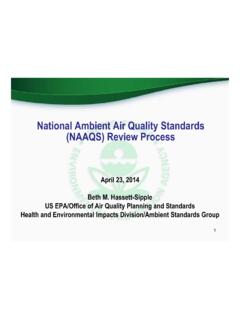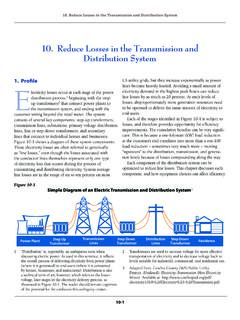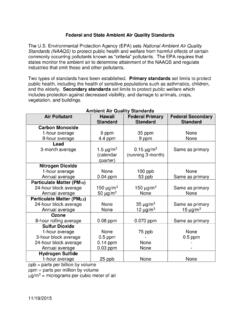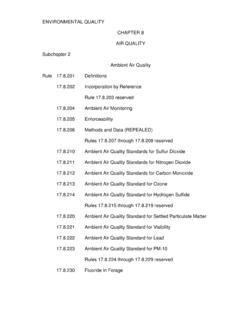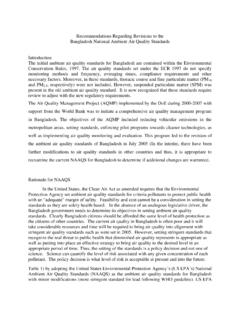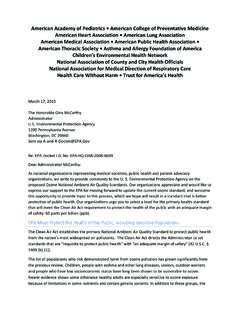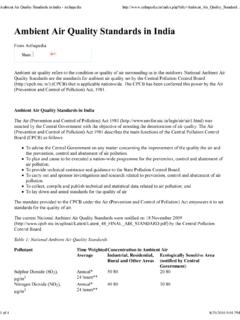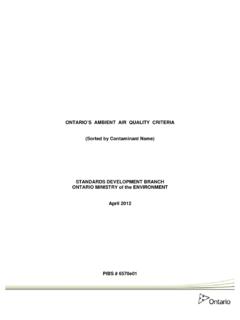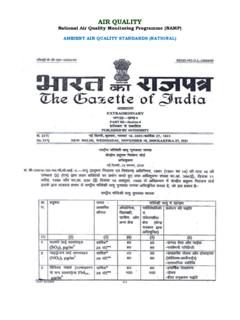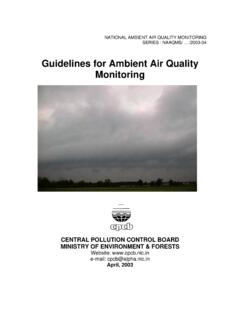Transcription of The 2015 National Ambient Air Quality Standards for Ozone
1 The 2015 National Ambient Air Quality Standards for Ozone Susan Lyon Stone NACAA Communicating Air Quality Conference March 15, 2016 Primary Ozone Standard The Clean Air Act requires a primary standard that is requisite to protect public health with an adequate margin of safety. This means that the Administrator must set a standard that, in her judgement, is no more or less stringent that necessary to protect at-risk groups. The Clean Air Act does not require that a primary standard eliminate all risk In making a decision about an adequate margin of safety, the Administrator considered the types and severity of health effects, the uncertainties in the science, and the need to protect at-risk groups. 2 How Does the 2015 Primary Ozone Standard Compare to the 2008 Standard? The level of the standard has been strengthened from 75 ppb to 70 ppb.
2 The other elements of the standard, including the averaging time and form, were retained without change. The new standard is met when the 4th highest daily maximum 8-hour average concentration, averaged over three years, is 70 ppb or lower. 3 Why Did EPA Revise the Ozone Standard? Extensive scientific evidence showed that revising the standard was necessary to protect public health with an adequate margin of safety, as the Clean Air Act requires. To determine what standard would provide that requisite degree of protection, EPA considered an expanded body of scientific evidence that includes thousands of studies on Ozone s effects on health. EPA focused on new studies that have become available since the 2008 review of the Standards . Those studies include new clinical studies, which provide the most certain evidence of health effects in adults.
3 Those studies provide information clearly showing that Ozone at 72 ppb is harmful to healthy exercising adults a level which is below the 2008 standard. 4 What are the Health Effects of Breathing Ozone ? A large body of scientific evidence, spanning several decades, shows that Ozone can cause harmful effects on the respiratory system, including: Coughing and sore throat or burning sensation in airways Reduction in lung function, making it harder to breathe deeply Inflammation and damage to the airways Aggravation of lung disease, including asthma, emphysema and bronchitis Increase in the frequency and severity of asthma attacks Repeated damage to developing lungs can affect children into adulthood, causing permanent reduction to the lungs ability to function, and is likely to be one of the many causes of asthma development.
4 5 What are the Health Effects of Breathing Ozone ? These effects can lead to: More medication use for people with asthma More frequent visits to the doctor Missed school days Missed work days More emergency room visits and hospital admissions Increased risk of premature death from lung or heart disease 6 What Groups Are Most At-risk from Exposure to Ozone and Why? People most at-risk from breathing air containing Ozone include people with asthma, children, older adults, and people who are active outdoors, especially outdoor workers. In addition, people with certain genetic characteristics, and people with reduced intake of certain nutrients, such as vitamins C and E, are at greater risk from Ozone exposure. Children, including teenagers, are among the most at-risk because their lungs are still developing, they breathe more air per pound of body weight than adults, and they spend more time outside than adults.
5 They are also more likely than adults to have asthma. An estimated million children in the have asthma, according to CDC estimates for 2013. That s equal to one in every 12 children in the country. 7 Respiratory Effects and Short-Term Exposures Controlled human exposure studies In the 2008 review, the strongest evidence was for respiratory effects in healthy adults engaged in intermittent, moderate exertion following exposures at or above 80 ppb Decreased lung function, increased respiratory symptoms, increased airway inflammation, increased airway responsiveness, decreased lung host defense More limited evidence at 60 ppb for decreased lung function and respiratory symptoms (Adams, 2002; 2006) In the 2015 review, recent studies by Schelegle et al. (2009) and Kim et al. (2011) have reported respiratory effects in healthy adults following exposures below 80 ppb 8 9 Human Clinical Studies.
6 Lung Function Young healthy adults hr exposures Intermittent, moderate exertion Data are group mean responses t triangular (ramp up, ramp down) concentration profile m exposure via facemask ISA Figure 6-1B 9 Respiratory Effects and Short-Term Exposures (Continued) Epidemiologic studies In the 2008 review, population-based studies reported positive, and often statistically significant, associations with lung function decrements, respiratory symptoms, medication use, and respiratory emergency department visits and hospital admissions Panel studies reported associations with lung function decrements in children and exercising adults In the 2015 review, recent multicity and single city population studies reinforce previous evidence for respiratory hospital admissions and emergency department visits Associations are consistently positive and often statistically significant.
7 Particularly for analyses focused on the warm season Associations remain robust after adjustment for co-pollutants No evidence for discernible threshold within range of daytime concentrations common in O3 season, though less certainty regarding shape of concentration-response curve at lower concentrations ( , about 20 to 40 ppb) 10 Total Mortality and Short-Term Exposures Total Mortality: Recent multicity and single city studies considerably strengthen the evidence for mortality in the current review Associations with mortality consistently positive and statistically significant, particularly in analyses of the warm season (A-1) As for respiratory effects, no evidence for discernible threshold within range of daytime concentrations common in O3 season, though less certainty regarding shape of concentration-response curve at lower concentrations ( , about 20 to 40 ppb) 11 Respiratory Effects and Long-Term Exposures Long-term epidemiologic studies typically evaluate associations with seasonal averages of daytime peak O3 concentrations ( , 8-hour, 1-hour max) Recent epidemiologic studies have greatly expanded the body of evidence for effects associated with long-term O3 exposure For example.
8 New onset asthma; asthma severity and control; asthma hospital admissions and ED visits; respiratory mortality Association with respiratory mortality is robust to adjustment for confounding by PM (other endpoints not evaluated in co-pollutant models) Collective evidence from the California Children s Health Study provides important information on genetic variability related to susceptibility and protective factors (anti-oxidant, anti-inflammatory) Experimental studies in nonhuman primates support the biological plausibility of repeated exposures contributing to development of asthma and irreversible, morphological changes in the lung 12 How Does the 2015 Ozone Standard Protect Public Health? In selecting the level of the standard, EPA focused on new studies that have become available since EPA last reviewed the Standards in 2008.
9 New clinical studies, which provide the most certain evidence of health effects in adults, provide information clearly showing that Ozone at 72 ppb is harmful to healthy exercising adults. The revised 2015 Ozone standard of 70 ppb is below the level shown to cause adverse health effects in the clinical studies. In addition, EPA focused on children s exposure. Combined, the results of the clinical studies and risk and exposure analyses show that a standard of 70 ppb essentially eliminates exposures that have been shown to cause adverse health effects, protecting percent of children from even single exposures to Ozone at or above 70 ppb. 13 What Are the Benefits of the 2015 Primary Ozone Standard? EPA estimated the benefits of meeting the new standard of 70 ppb, and they are significant. Reducing Ozone and particle pollution nationwide (excluding California) in 2025 will avoid: 320 to 660 premature deaths 230,000 asthma attacks among children 160,000 days when kids miss school 28,000 missed work days 630 asthma-related emergency room visits 340 cases of acute bronchitis among children 14 What is the Air Quality Index?
10 The Air Quality Index (AQI) is EPA s color coded tool for telling the public how clean or polluted the air is, and recommending steps people can take, if necessary, to reduce their daily exposure to pollution. The AQI converts Ozone concentrations to a number on a scale from 0 to 500. This scale is used by cities and states across the country to report current and daily Ozone concentrations and for daily Ozone air Quality forecasting. 15 What are the revised AQI breakpoints? EPA updated the breakpoints for each AQI category for Ozone , based on the strengthened primary (health) 8-hour Ozone standard and on information from the health studies that were examined as part of the review of the standard. The agency set the 100 value of the index the level of the Ozone health standard. That s 70 parts per billion, or ppb. An AQI of 100 is the upper end of the Moderate or Code Yellow range.
